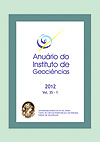Fossil earthquake evidenced by the silicified tectonic breccia of the cabo frio area, state of Rio de Janeiro, Brazil, and its bearings on the genesis of stick-slip fault movement and the associated amagmatic hydrothermalism
DOI:
https://doi.org/10.11137/2012_2_124_139Abstract
This paper shows present the present state of the geologic and petrographic studies of the silicified tectonic breccia in the Cabo Frio area, State of Rio de Janeiro, Brazil. Based on the results, the authors propose a model for the stick-slip fault displacement. The tectonic breccia zones are 50 cm to 20 m wide and of NE-SW general strike. They are cut by early Cretaceous mafic dykes. The clasts are angular and characterized by auto-brecciation texture. The matrix is firmly consolidated by the silicification with the dissemination of hematite, carbonates, and sericite. The breccia zones are distributed randomly in a wade area of the State of Rio de Janeiro. This observation affirms that the silicification cannot be related to the local magmatism of Cretaceous to early Cenozoic alkaline intrusions. An alternative idea is the hydrothermalism originated form geothermal gradient. According to the normal continental geothermal gradient, of 25 to 30ºC/km, the temperature attributed to the depth from 6 to 8 km is 180 to 220ºC. In this condition, the H2O present there behaves as hydrothermal liquid. This type of hydrothermalism, without participation of magmas, is called amagmatic hydrothermalism. When a earthquake occurs, a cataclastic zone is formed. The surface water migrated down through it and arrived at the depth of 6 to 8 km transforms into amagmatic hydrothermal liquid. According to the stress adjustment and consequent accommodation of the crustal rock blocks, the hydrothermal liquid is compressed and forced to rise up along the cataclastic zone. During the ascension and cooling of the hydrothermal liquid, the cataclastic zone is silicified and consolidated. The silicified tectonic breccia observed in the studied area can represent this phenomenon which took place in the geologic time. By means of the silicification and consolidation, the fault plane transforms form a weak zone into a mechanically firm zone. This transformation enables the accumulation of tectonic energy in form of elastic deformation. That is, during and just after the earthquake, the fault plane is a weak zone. However, in the period between earthquakes it is a firm zone. The clasts of the fault breccia are composed of silicified cataclastic rock. This observation indicates that the fault plane rupture and its hydrothermal consolidation took place repeatedly, which implies repeated earthquakes along the same fault. The authors propose this process as an additional mechanism for stick-slip movement of the faults. The amagmatic hydrothermalism can be a geologic representation of asperity. It is a seismologic conception that corresponds to the specific locality on the fault plane in which the fault movement is stagnated and tectonic energy is accumulated in form of elastic deformation. A new earthquake occurs by means of asperity rupture.Downloads
Download data is not yet available.
Downloads
Published
2012-12-01
How to Cite
Motoki, A. (2012) “Fossil earthquake evidenced by the silicified tectonic breccia of the cabo frio area, state of Rio de Janeiro, Brazil, and its bearings on the genesis of stick-slip fault movement and the associated amagmatic hydrothermalism”, Anuário do Instituto de Geociências. Rio de Janeiro, BR, 35(2), pp. 124–139. doi: 10.11137/2012_2_124_139.
Issue
Section
não definida
License
This journal is licensed under a Creative Commons — Attribution 4.0 International — CC BY 4.0, which permits use, distribution and reproduction in any medium, provided the original work is properly cited.















